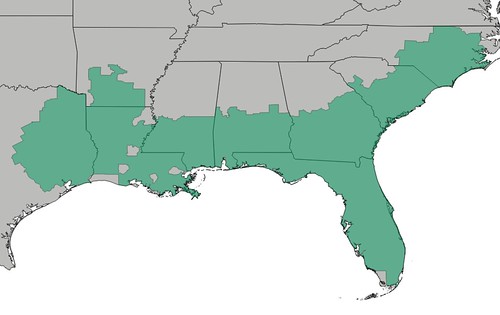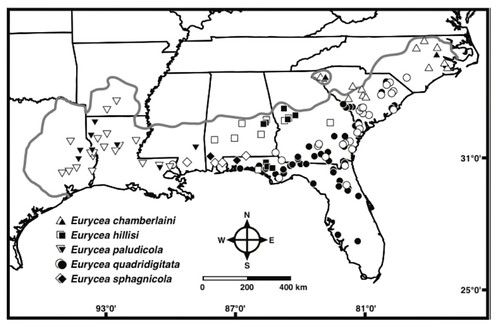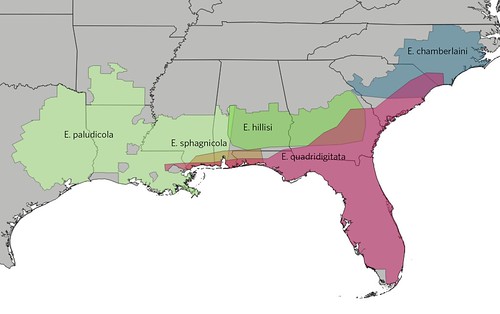Eurycea quadridigitata split
During IUCN's 2004 Global Amphibian Assessment, they treated the Eurycea quadridigitata complex as a complex of two species: Eurycea quadridigitata (sensu 2004) and Eurycea chamberlaini which had been recently split off. But they didn't include a range for E. chamberlaini and their range for E. quadridigitata was from before E. chamberlaini was split off (ie E. quadridigitata sensu pre-2004):

iNat has followed suit with just these two species in Eurycea quadridigitata complex. I hand drew an approximate range for E. chamberlaini, but E. quadridigitata is still using the original (E. quadridigitata sensu pre-2004) IUCN range.
A recent 2017 paper by Wray et al. further splits up the complex by carving off 3 new species from E. quadridigitata (sensu 2004): E. hillisi, E. paludicola, & E. sphagnicola

Amphibian Species of the World has added these new species.
I've taken a crack at adapting this figure into new ranges for E. hillisi, E. paludicola, & E. sphagnicola and another crack at E. chamberlaini and E. quadridigitata (sensu 2017):

Currently, iNat is explicitly deviating from Amphibian Species of the World by treating the Eurycea quadridigitata complex as just 2 species: E. chamberlaini and E. quadridigitata (sensu 2004).
Would folks be ok with rather going with Amphibian Species of the World in this case? Steps would be:
1) Create taxa for E. hillisi, E. paludicola, E. sphagnicola & E. quadridigitata (sensu 2017) with the above ranges
2) update the existing E. chamberlaini range with the one above
3) split E. quadridigitata (sensu 2004) into E. hillisi, E. paludicola, E. sphagnicola & E. quadridigitata (sensu 2017)
This has been already proposed in a flag here. Thoughts?


 Usá ArgentiNat con app iNaturalist
Usá ArgentiNat con app iNaturalist






Comentarios
I think this paper seems to have been well accepted.
SSAR has also accepted these taxa and included them in their list of North American herps.
Identification in the areas of overlap may be tricky with some records, but those areas are relatively small compared to the whole range of the species complex.
drafted https://www.inaturalist.org/taxon_changes/38209
I was just attempting to upload some photos of E. paludicola. The referenced paper seems to be well-written, well-researched, and widely accepted in the herpetological community. I was also hoping to photograph sphagnicola and hillisi this winter, and so would like to see all three of these taxa added to iNat!
I agree. I added a record for E hillisi but it is hiding under the ID of E quadridigitata since nobody could select hillisi as an option. They are really quite distinct when you see them in person. Or in photos.
When will these taxa become active? I am new to the "inner workings" of iNaturalist, but if there is some legwork I can do to help out (with some coaching so I don't screw anything up) I am willing.
ok this is split any help ID'ing the observations formerly attributed to Eurycea quadridigitata (sensu lato) much appreciated
https://www.inaturalist.org/taxon_changes/38209
I also updated the range here https://www.inaturalist.org/taxa/27095-Eurycea-chamberlaini so please take a look at those obs too since that species is a bit intertwined with this one
Excellent!
Wray et al suggest common names for these species, which do not appear adopted by iNaturalist. Also, I had Eurycea quadridigitata on the restricted species list for a traditional project I manage (Herps of Arkansas) which got dumped--not updated--on the taxon change.
Agregar un comentario